Click on images to enlarge
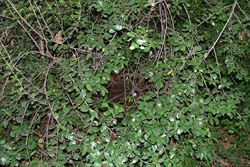
habit (Photo: Sheldon Navie)
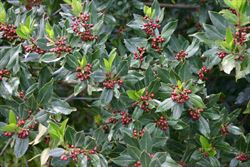
habit in fruit (Photo: Trevor James)
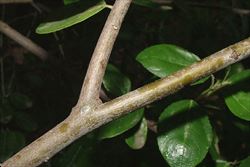
older stems (Photo: Sheldon Navie)
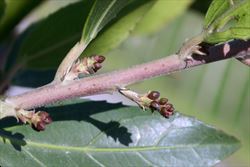
close-up of younger stem with flower buds (Photo: Trevor James)
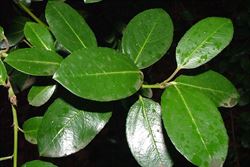
leaves (Photo: Sheldon Navie)

close-up of dark green leaf with finely-toothed margins (Photo: Trevor James)

close-up of paler leaf underside (Photo: Trevor James)
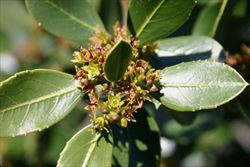
clusters of male and bisexual flowers (Photo: Trevor James)
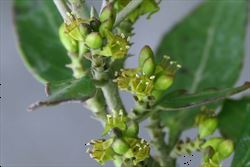
greenish-coloured male flowers (Photo: Trevor James)
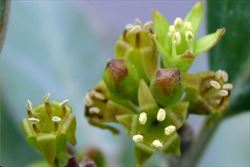
close-up of male flowers with five stamens (Photo: Trevor James)
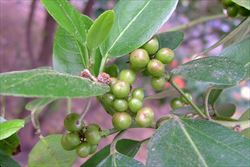
immature fruit (Photo: Sheldon Navie)
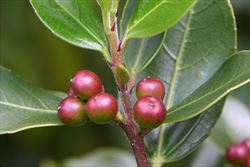
close-up of mature fruit (Photo: Trevor James)
Scientific Name
Rhamnus alaternus L.
Family
Rhamnaceae
Common Names
blow-fly bush, blowfly bush, buckthorn, evergreen buckthorn, Italian buckthorn
Origin
Native to southern Europe (i.e. France, Portugal, Spain, Albania, Italy, Greece and Ukraine), north-western Africa (i.e. Algeria, Libya and Turkey) and western Asia.
Cultivation
Italian buckthorn (Rhamnus alaternus) has been widely cultivated as a garden ornamental or hedging plant in the temperate regions of Australia.
Naturalised Distribution
Widely naturalised in the temperate regions of southern Australia (i.e. in the coastal and sub-coastal districts of central and southern New South Wales, in Victoria and Tasmania, in many parts of southern South Australia and in the coastal districts of south-western Western Australia). Also sparingly naturalised in the cooler sub-coastal districts of south-eastern Queensland.
Naturalised overseas in New Zealand.
Habitat
A weed of coastal environs, riparian vegetation, grasslands, open woodlands, dry sclerophyll forests, rocky outcrop vegetation, plantations, disturbed sites, waste areas and roadsides in temperate regions.
Habit
A large shrub or small tree growing up to 5 m tall.
Distinguishing Features
- a large shrub or small tree growing up to 5 m tall.
- the alternately arranged leaves are borne on short stalks and have sharply toothed margins.
- its tiny greenish flowers (up to 3 mm long) are borne in small dense clusters in the leaf forks.
- separate male and bisexual flowers are produced in these clusters, with the majority of the flowers being male.
- the small berry-like fruit (3-5 mm across) turn from green to red, and then eventually to black or brown, as they mature.
Stems and Leaves
Older branches have dark brown furrowed bark, while younger branches are pale brown or purplish in colour. Younger stems are greenish and hairless (i.e. glabrous) or finely hairy (i.e. puberulent).
The alternately arranged leaves are simple and borne on short stalks (i.e. petioles) 2-12 mm long. These leaves (2-7.5 cm long and 0.5-4 cm wide) are oval (i.e. elliptic) to egg-shaped in outline (i.e. ovate) with sharply toothed (i.e. serrate) margins and pointed tips (i.e. acute apices). They are hairless (i.e. glabrous) and somewhat leathery in nature with dark green and glossy upper surfaces and paler undersides.
Flowers and Fruit
The inconspicuous greenish or yellowish-green flowers (up to 3 mm long) are borne in small dense clusters (0.5-2 cm long) in the leaf forks (i.e. axils). Separate male and bisexual flowers are produced in these clusters (i.e. this species is monoecious), with the majority of the flowers being male (i.e. staminate) and only a few bisexual flowers present towards the top of each cluster. Each flower is borne on a short stalk (i.e. pedicel) 1-2 mm long and has five tiny sepals and four or five petals that are fused at their bases into a tiny tube (i.e. corolla tube) about 2 mm long. The bisexual flowers have five stamens and an ovary topped with a branched style, while the male flowers only have the five stamens. These fragrant flowers are produced during winter and early spring (i.e. from May to October).
The small berry-like fruit (i.e. drupes) turn from green to red, and then eventually to black or brown, as they mature. These fruit (3-7 mm across) are rounded in shape (i.e. globose) and usually contain three hard nutlets. They are mainly present during summer.
Reproduction and Dispersal
This species reproduces mainly by seed, however plants will re-shoot vigorously from the base whenever they are damaged.
The seeds are often spread by fruit-eating (i.e. frugivorous) birds, especially blackbirds, and other animals. However, they may also be spread in dumped garden waste.
Environmental Impact
Italian buckthorn (Rhamnus alaternus) is regarded as an environmental weed in Victoria, Tasmania, South Australia and Western Australia, and was recently listed as a priority environmental weed in four Natural Resource Management regions.
This species is a particularly serious environmental weed in south-eastern Australia, where it has escaped into native vegetation and formed large naturalised populations. It is a hardy, adaptable species that grows on a range of soil types and will stand considerable drought. Italian buckthorn (Rhamnus alaternus) crowds out and replaces native species in the shrub layer, and its dense growth prevents light reaching ground-cover plants. This species is quick growing and is particularly invasive in coastal woodlands and dune systems. Because its growth rate is faster than most native shrub and tree species, Italian buckthorn (Rhamnus alaternus) quickly dominates the vegetation out-competing sub-canopy species in all forest types, and infiltrating the canopy of lower scrubby vegetation types. It can form dense stands and may eventually cause the exclusion of all other vegetation.
Italian buckthorn (Rhamnus alaternus) is possibly of most concern along the south coast of Victoria, where it is seen as a very serious threat to one or more vegetation formations. For example, it is highly invasive in coastal dune scrub vegetation and coastal alkaline scrub vegetation and is a significant weed in threatened coastal moonah woodlands in this state. It also appears on several local and regional environmental weed lists in Victoria (e.g. in the Shire of Yarra Ranges, Surf Coast Shire, Moyne Shire, Mornington Peninsula Shire and in the Geelong region) and is classed as a major environmental weed in Mornington Peninsula National Park.
In South Australia, Italian buckthorn (Rhamnus alaternus) is regarded as posing a threat to Adelaide's biodiversity. It is a common invasive garden plant in the greater Adelaide region and also occurs in coastal dunes and inland wooded areas in other parts of the state. It also appears on local environmental weed lists (e.g. in the City of Mitcham and the City of Tea Tree Gully) and in conservation areas (e.g. Marino Conservation Park, Belair National Park and Onkaparinga River Recreation Park) in this state.
Italian buckthorn (Rhamnus alaternus) is also becoming a major weed in waterways in south-western Western Australia and was recently ranked as a moderately important environmental weed in the Environmental Weed Strategy for Western Australia. While it currently has a relatively limited distribution it is seen as a potentially a serious weed of disturbed bushland. Unlike in south-eastern Australia, it is more of a problem along rivers and creeks in this part if the country. It has been reported from Rottnest Island, on the Swan River cliffs, in the Helena Valley and at Harvey.
In New Zealand, Italian buckthorn (Rhamnus alaternus) is a weed of coastal areas, and is especially prominent on exposed cliff-faces on offshore islands. In these habitats it forms dense stands that nothing will grow underneath.
Legislation
Not declared or considered noxious by any state government authorities.
Management
For information on the management of this species see the following resources:
- Muyt (2001), Bush Invaders of South-east Australia, pp. 213-214.

